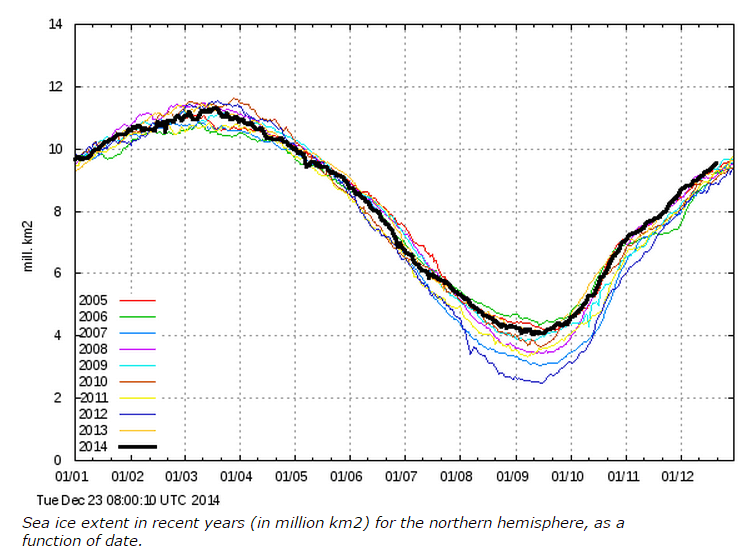Arctic sea ice extent continues its march into record territory for the past decade.
Four years since Mark “Death Spiral” Serreze predicted a record low in 2010, and I was a denier for disagreeing with him.
As Arctic sea ice shrinks faster than 2007, NSIDC director Serreze says, “I think it’s quite possible we could “break another record this year.” | ThinkProgress




And another day of melting glaciers and melting land ice on Greenland and Antarctica. Sea ice, by the way, does not influence the water level, melting land ice does…
And another day of moronic postings from natural climate change deniers.
You won the award for genius of the day. And so early!
http://stevengoddard.wordpress.com/2014/12/23/climate-genius-of-the-day-2/
Melting land ice in the middle of winter??? OH Noes!
Of course it would have to get above freezing and the current high temperature in Greeland is Ikermiuarsuk, Greenland 26 °F
Of course on the low is Summit, Greenland -61 °F
Antarctica melting? Oh yes melting because of geothermic heat. It is in a volcanically active area as is the Arctic.
Researchers Find Major West Antarctic Glacier Melting from Geothermal Sources
Volcanoes Eurpt Beneath Arctic Ice
NASA: Arctic Sea Ice
Photo from the article shows ice being driven out of Bering Strait
http://earthobservatory.nasa.gov/Features/SeaIce/images/bering_strait_sea_ice.jpg
It’s winter, dimwit.
If anyone struggles to follow the science at least understand the psychology. Years ago, I had to explain that the melting of floating ice doesn’t raise see levels to a passionate CAGW believer. They felt stupid so now they throw it back.
sea levels. OOPS
Yes, isn’t it amazing how these guys see melting ice while standing in the middle of a blizzard.
Looking at these polar graphs over the years, I’m convinced that Ice variability in what ever form, is controlled by earths orbital parameters, there’s is also a correlation between the expansion and contraction of the solarsystems planetary orbits, and a correlation between solar activity increasing and decreasing in the timing of the suns polar magnetic field reversals that correlate with the solarsystems orbital parameters.
I haven’t seen any evidence that Ice formation on earth is controlled by fluctuations in atmospheric composition. regardless of the cause.
Queue alarmists sceptics lol
Fifty bucks says Serreze and his band of zealots (death spiral barbie, etc) will be posting graphs showing current levels below the 30 year median even after the satellite photos have ice beyond the orange line everywhere.
No takers. We already know they are a band of lying thieves and the MSM protects their backsides.
Heck despite the brawls in NYC and two officers in the hospital the lying MSM is calling the NYC protests ‘peaceful’ with no violence.
At least five officers have been assaulted by protesters — including two leitanents … a police barricade and some tossed garbage cans at police cars.
a group of protesters surrounded a pair of traffic agents in a marked police car and smashed the rear window with a trash bin and a side window with a metal pole.
Poet and adjunct CUNY professor who attended Harvard… was charged with assault, weapons [hammers] and marijuana possession, resisting arrest and rioting.
This is a real goody:
http://www.nydailynews.com/new-york/anti-police-remarks-dispute-911-center-sources-article-1.2054253
Seems a 911 operator said “The cops deserved it. as they lay dying.”
http://ocean.dmi.dk/arctic/icecover.uk.php
The ice extent has been adjusted. Its not back to the mean after all. Who would have thought.
There are good chances that we’ll be back to pre-2005 levels in 2015
http://arctic.atmos.uiuc.edu/cryosphere/IMAGES/seaice.anomaly.arctic.png
with anomalies not smaller than -1 million km2.
I think what happens will depend on the Atlantic Multidecadal Oscillation and when it switches to the cold mode.
An old WUWT from four years ago: The Atlantic Ocean via the AMO drives the apparent “Global Warming” By Joseph D’Aleo
A better overall view: icecap.us/docs/change/OceanMultidecadalCyclesTemps.pdf
In one of Bastardi’s recent reviews, he noted the past pattern with that switch includes a false start for a year or two, perhaps a year that looks warm again, then the flip. If that happens again, the gains in extent we’re seeing these last two years might recede a bit before coming back in force.
This is from Jun of this year. Since I live on the east coast I notice all that warm water jammed against the USA east coast lately.
You can see that warm water even now:
http://www.ospo.noaa.gov/data/sst/anomaly/anomwnc.gif
Thanks Gail, I didn’t know about this feature of the final phase of the warm AMO, with increased warmth in the east coast.
It’ll be interesting to watch it from now on.
The main point of my previous comment was the possibility of shortening of the period of the oscillation (positive AMO), correlated with low solar radiations.
I agree, Gail, my comment was in part based on J. D’Aleo’s analysis.
I’m also betting in a considerable lowering of solar radiations– assuming that the solar max lasted from the end of 2011 to now– but this is the real difficult part to predict.
I’m convinced that the present solar cycle is quite low.
Despite the spike of intensity this year, it was not enough to change the general trend back to warming or even neutral. In particular, it could not change the trend of ENSO, which I consider an important parameter for solar forcing.
Earth’s climate is still cooling, with great prospects of acceleration during the decline phase of the solar cycle.
The relatively low level of radiations seem to be altering the Atlantic anomalies already and could possibly shorten the usual period of the positive AMO for many years.
One problem that I usually notice with the analyses of good meteorologists, like J. D’Aleo and J. Bastardi, is that they don’t talk much about the Sun, and this limits their conclusions to some extent (IMO).
Even using the correlation with the AMO, the recovery of the Arctic ice in the last 2 years could be another indication of the AMO starting to flip.
It’s not a recurrent argument IMO, because the whole system probably works self-consistently and, as far as I can tell, it’s strongly correlated with the radiations too.
As someone said once, we live in the “breath” of the Sun. We cannot forget this.
Dmh, The energy going into the oceans comes from the sun. But there is a group often seen at WUWT that think the ocean osscillations are completely internal and have nothing to do with any outside forcings.
From the poking around I have done on the subject, it looks like one possible connection is :
? UV====> ? ozone
? ozone ===> ? Quasi-Biennial Oscillation
There are also links in the changes in ozone and changes in the winds that drive the Antarctic Circumpolar Current. Changes in that current coupled with the constrictions at the tip of South American and Africa affect the Pacific and Atlantic. (The infamous teleconnection perhaps?)
Some other interesting tidbits:
Kirkland, Matt W.; Tinsley, Brian A.; Hoeksema, J. Todd
Journal of Geophysical Research, Volume 101, Issue D23, p. 29689-29700, 1996.
DOI: 10.1029/96JD01554
Atmospheric Dynamical Responses to Solar Wind Variations on the Day-to-Day Timescale.
Tinsley, B. A. [[email protected]]
American Geophysical Union, Fall Meeting 2001, abstract #A11A-0031, 2001
Too bad all the time and money is wasted on beating the CO2 dead horse.
The latest from our dear friends at the NOAA regarding Arctic sea ice:
http://www.esrl.noaa.gov/psd/news/2014/122214.html
Just looked at an old Britannica atlas printed in 1980.
http://s5.postimg.org/9lfzx0e7b/brit_atlas.jpg
The graphic of the Arctic ice is interesting. It doesn’t state what season the map represents but I compared it with the September mean for 1979-2000. The Brit atlas has the Queen Elizabeth Islands ice free while the Sep mean doesn’t. The same with Victoria Island. The areas that seem to represent surfaces that are much less than 100% ice extend to the Alaska in the Beaufort sea but not near the Russian coast at all. The East Siberian Sea and Bolshevik Island are ice free in the Brit Atlas.
We also have the ice something like 1000 km from Alexandra Strait but apparently the Russian ship sailing there is a sign that the Arctic could be ice free in just 6 years.
http://www.thestar.com/news/canada/2014/12/22/icefree_arctic_could_be_just_six_years_away.html
Its clear that the average minimum sea ice extent for 1979-2000 was much larger than in the 70s.